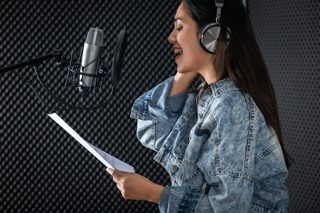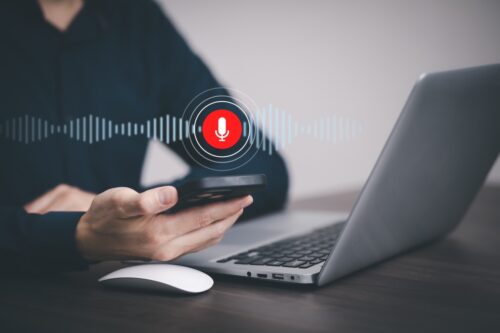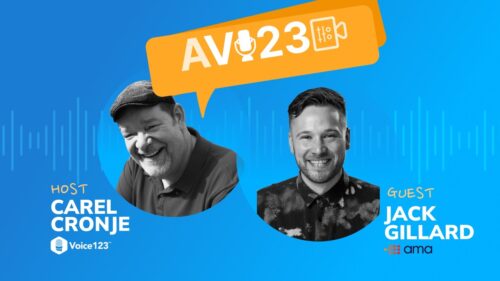Dynamic audio ads use data and tech to give listeners personal, programmatic audio advertising. The result? Meaningful content that captures attention cultivates loyalty and speaks to the heart. How is it possible? In this episode of AV123 – an audiovisual show powered by Voice123, Jack Gillard, creative production manager at A Million Ads (AMA), shares insights on the impact of data triggers on digital audio advertising.
At Voice123, where you’ll find pro advertising voice actors – we believe in the longevity of digital audio advertising. So, here’s a summary of Jack’s key insights for successful dynamic audio ads.
Listen and download the full episode here:
What are dynamic audio ads?

Dynamic audio ads are personalized promo messages in audio programs like podcasts that adapt to individual listeners based on data triggers like location, demographics, and listening behavior. Compared to traditional audio ads, dynamic audio transforms ad copy, CTAs, and promoted products in real-time using innovative advertising approaches. An audio advertising agency can deliver tailored messages their target audience finds meaningful.
Jack Gillard notes: “Dynamic audio is how we tailor our messaging to audiences…we can change the messaging…to make it much more personal to the listener at that moment. It can even match their interests.”
The evolution of dynamic audio advertising
In a digital world, companies are constantly vying for consumer attention. Advertising is everywhere – from Spotify ads to bus posters. But dynamic audio ads mark a seismic shift to programmatic audio advertising and real-time bidding. Listeners get personal messages according to location and listening behavior. This transition reduces ad fatigue because the content is made for the target audience. For example, an audio advertising agency can use data analytics and AI algorithms to form connections with consumers.
Jack explains, “It’s more relevant to your moment, to what you’re thinking. It can be a more enjoyable experience rather than just being an ad that comes in out of nowhere and changes your mood.”
How to create dynamic audio ads
1. Define your target audiences
Use tools like Google Analytics to create buyer personas with needs and pain points. If you have a fitness app that targets busy pros, your details would include age (25-40), occupation (white-collar), fitness goals (stress management), and preferred exercise (yoga).
2. Identify key data points
Mixpanel or CRM software helps you gather data for apps, websites, or customer interactions to analyze user engagement, conversion rates, and customer feedback metrics. For a health brand, this analysis could reveal the top supplements that app users viewed or added to their wish list.
3. Use sequencing and context
Jack Gillard explains that sequencing is about “creating a world that is very similar to listeners… how it will fit into their day-to-day routine.” So, adapt your content to data triggers like locations, weather, tone, distribution platforms, and time of day to match listeners’ moods and expectations.
4. Incorporate storytelling
Appeal to emotions with challenges and desires to make products more engaging. Jack shared an example of a dating app. “The first time listeners hear the ad, it’s about a couple’s first date; the second is their wedding day; the third is their new family. So, they’re all coming back with perfect love stories!”
5. Invest in quality voice overs
People buy from people, and voice acting makes brand stories dynamic. Jack notes the uniqueness of voice acting: “If they’re high energy, if it’s a sports read, you need more punchy, but if it’s a luxury brand, you’ll want to pull back…keeping those great elements of a typical commercial.”
Listen to Jack Gillard’s full interview with AV123 to get more info on creating dynamic audio.
Voice overs and collaboration in audio advertising

Collaboration comes down to every team member. It’s a partnership running through entire teams. At times, recording sessions take longer, becoming physically and emotionally taxing. So, for smooth programmatic audio advertising, there must be trust between the audio advertising agency, voice actor, director, and engineer.
Jack shares an apt experience:
“In a virtual studio, I put a lot of trust in the engineers to be my safety blanket. It’s the same with the voice actor; I want them to bring their experience and engagement to life. And with anything creative, I think working together from the start makes for a better experience. Just because somebody isn’t in a creative role doesn’t mean they don’t have something to say. I’m going to use their experiences; if they’ve got a thought, let’s bring it together and make a better piece of creative altogether.”
Need a voice actor for your audio ads? Check out Voice123 to find awesome vocal pros.
Dynamic audio ads: Trends and strategies
Future trends in audio advertising

- AI algorithms can analyze listener data and generate automated content for dynamic ad creation based on individual preferences.
- Integrating data streams like location, weather, and device type helps digital audio advertising dynamically adjust, maximizing relevance.
Here are some of Jack’s insights about the death of cookies.
- Without cookies, tracking user behavior across websites challenges audio advertising agency strategies. Dynamic audio ads are an alternative channel for reaching audiences with anonymized data that bypasses tracking reliance.
- Audio platforms can leverage on-demand targeting based on genres and listener demographics because dynamic audio ads adapt to new privacy landscapes.
Strategies for cost-effective dynamic audio ads
- Partner with podcasts to reach engaged audiences without excessive production resources.
- Encourage user-generated content through interactive audio campaigns.
- Use automation tools and platforms to reduce production costs and turnaround times.
- Gather insights from listener data to understand preferences, behaviors, and trends.
- Plan content that can be repurposed and adapted with evergreen themes and messaging throughout the year.
Final Thoughts
Dynamic audio ads represent a transformative approach to advertising in the digital age. Jack Gillard’s insights into data triggers and innovative technologies explain how personalized messages create digital audio advertising that your target audiences want to listen to. So, dynamic audio ads are the key to grabbing attention and connecting to global consumers.
Need a vocal pro for your ads? Find an expert voice at Voice123 or hire our Managed Services team to handle your ad project from start to finish. And don’t forget to subscribe to AV123 on your favorite podcasting platform for the latest AV insights!
Turn up the volume of your audio ads!
FAQs
It’s a promotional message played on audio channels like radio, streaming services, or podcasts to reach audiences with audio content.
They’re ads distributed across Google’s platforms to target music, podcasts, or audio content listeners on YouTube Music, Spotify, or other streaming services.
It depends on the platform and settings; YouTube allows users to skip the ads after a few seconds, while other platforms require listening to the entire ad.
Music streaming platforms like Spotify may play audio ads between songs for users with a free membership, which monetizes the service.
